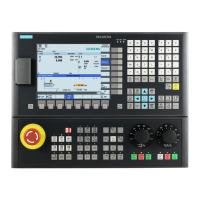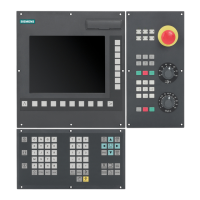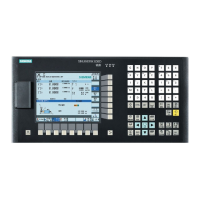P2: Positioning axes
10.2 Own channel, positioning axis or concurrent positioning axis
Extended Functions
604 Function Manual, 03/2013, 6FC5397-1BP40-3BA1
Dependencies
Positioning axes are dependent in the following respects:
● A shared part program
● Starting of positioning axes only at block boundaries in the part program
● With rapid traverse movement
G0 path axes traverse as positioning axes in one of two
different modes
● No rapid traverse override
● The following interface signals act on the entire channel and therefore on positioning
axes:
– DB21, ... DBX7.1 (NC start)
– DB21, ... DBX7.3 (NC stop)
– DB21, ... DBX7.7 (reset)
– DB21, ... DBX6.1 (read-in disable)
● Alarms specific to program and channel also deactivate positioning axes.
● Program control (dry run feed, program test, DRF, ... etc.) also act on positioning axes
● Block search and single block also act on positioning axes.
● The last block with a programmed end-of-motion criterion that was processed in the
search run serves as a container for setting all axes.
● Group 1 (modal movement commands) of the G functions
G0, G1, G2, ...) does not apply to
positioning axes.
References:
Programming Manual Fundamentals.
Applications
The following are typical applications for positioning axes:
● Single-axis loaders
● Multi-axis loaders without interpolation (PTP → point-to-point traversing)
● Workpiece feed and transport
Other applications are also possible:
● With
G0 workpiece delivery and workpiece transport can travel to their end points
independently of one another.
● On machines with several machining processes in sequence: Significant reduction in
individual machining steps due to block change in the braking ramp of the single-axis
interpolation.
Note
Positioning axes are not suitable for multi-axis loaders that require interpolation between
the axes (path interpolator).

